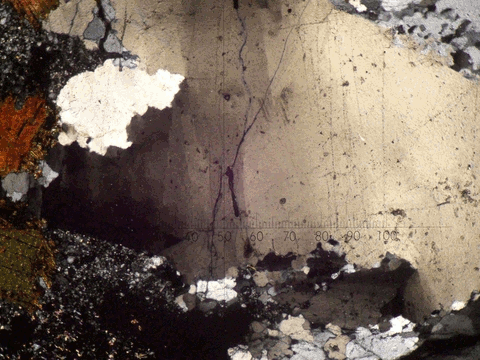
Extinction angle
Encyclopedia

Optical mineralogy
Optical mineralogy is the study of minerals and rocks by measuring their optical properties. Most commonly, rock and mineral samples are prepared as thin sections or grain mounts for study in the laboratory with a petrographic microscope...
and petrology
Petrology
Petrology is the branch of geology that studies rocks, and the conditions in which rocks form....
, which describes when cross-polarized light dims
Lighting
Lighting or illumination is the deliberate application of light to achieve some practical or aesthetic effect. Lighting includes the use of both artificial light sources such as lamps and light fixtures, as well as natural illumination by capturing daylight...
, as viewed through a thin section
Thin section
In optical mineralogy and petrography, a thin section is a laboratory preparation of a rock, mineral, soil, pottery, bones, or even metal sample for use with a polarizing petrographic microscope, electron microscope and electron microprobe. A thin sliver of rock is cut from the sample with a...
of a mineral
Mineral
A mineral is a naturally occurring solid chemical substance formed through biogeochemical processes, having characteristic chemical composition, highly ordered atomic structure, and specific physical properties. By comparison, a rock is an aggregate of minerals and/or mineraloids and does not...
in a petrographic microscope
Petrographic microscope
A petrographic microscope is a type of optical microscope used in petrology and optical mineralogy to identify rocks and minerals in thin sections. The microscope is used in optical mineralogy and petrography, a branch of petrology which focuses on detailed descriptions of rocks...
. An isotropic minerals, opaque (metallic) minerals, or amophous materials (glass) show no light (i.e. constant extinction). Anisotropic minerals will show one extinction for each 90 degrees of stage rotation.
The Extinction angle is the measure between the cleavage direction or habit of a mineral and the extinction. To find this, simply line up the cleavage lines/long direction with one of the cross hairs in the microscope, and turn the mineral until the extinction occurs. The number of degrees the stage was rotated is the extinction angle, between 0-89 degrees. 90 degrees would be considered zero degrees, and is known as parallel extinction. Inclined extinction is a measured angle between 1-89 degrees. Minerals with two cleavages can have two extinction angles, and minerals in which the multiple angles are the same are called symmetrical extinction. Minerals that have no cleavage or elongation can not have an extinction angle.
Minerals with undulose extinction
Undulose extinction
Undulose extinction or undulatory extinction is a geological term referring to the type of extinction that occurs in certain minerals when examined in thin section under cross polarized light. As the microscope stage is rotated, individual mineral grains appear black when the polarization due to...
, solid solution
Solid solution
A solid solution is a solid-state solution of one or more solutes in a solvent. Such a mixture is considered a solution rather than a compound when the crystal structure of the solvent remains unchanged by addition of the solutes, and when the mixture remains in a single homogeneous phase...
/zonation, or other factors (e.g. Bird's eye extinction in mica) that may inhibit this measure and may be more difficult to use.

